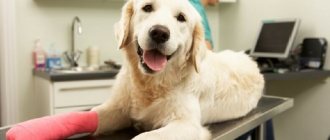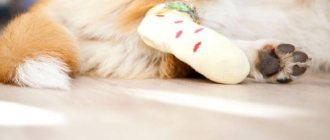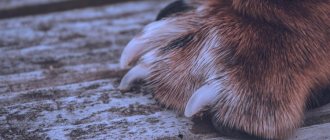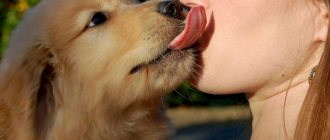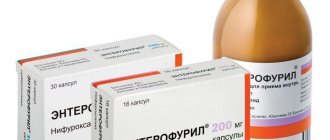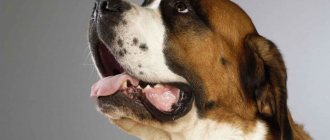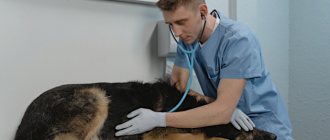Cracks in a dog's paws are usually accompanied by painful and unpleasant sensations for your pet. Where do they come from and what is the reason for their appearance? Are cracked pads a genetic condition, or is it a reaction to the environment? How to prevent cracks from appearing and how to help a four-legged paw if they occur? Let's try to answer the questions posed.
Many dog owners do not pay serious attention to the condition of their pet's paw pads. We begin to pay attention to them only when the dog begins to limp or lick its wounds. This is a fundamentally wrong approach. Paw pads play a very important role in the life and health of your pet. They are a kind of litmus test for the state of the body. And, if you value your pet, then you need to pay no less attention to them than to concerns related to feeding and walking the dog.
Causes of cracks
First of all, you need to understand that the pads are a kind of natural shock absorbers, the role of which is to reduce the load on the skeleton. This is especially true for representatives of service breeds who have to move a lot and run on hard surfaces.
It also happens that owners, trying to introduce their pet to active exercise, begin to intensively walk and train them. Such experiments lead to the fact that after jogging, the pads on the paws quickly become covered with cracks, causing considerable discomfort, even lameness, and pain.
Considerable damage to paws is caused by hot asphalt, ice, snow, as well as reagents used to treat roads during the cold season. Snow crystals, sticking to the pads, injure the paws, “chemicals” penetrate into the cuts, the skin on these parts of the body becomes dry, rough, often red, and then cracks appear on it.
Some dogs, as a rule, are representatives of decorative breeds, whose pads are naturally so soft and gentle that the use of special shoes during walks becomes not a whim, not a tribute to fashion, but a stern necessity, protection from all types of chemicals.
In addition, the pads react very sensitively to changes in nutrition, especially to a lack of components such as zinc and selenium. If they are absent from the food, then cracks on the dog’s paw pads will not be long in coming.
Thus, the reasons contributing to the appearance of cracks include hard road surfaces, climatic conditions and poor care of the animal (improper feeding, lack of water and, as a result, dehydration). If these factors are eliminated, the paws may well become overgrown spontaneously.
rough paw pads
Depending on what you mean by “cracks” and “calluses”, otherwise these concepts can fit a lot of different things.
And yes, the dog needs to be taught to walk on gravel and stones - they didn’t just take it and run. First, walk at a pace so that the tendons become toned and the dog is able to hold his paw in a lump on such soil. Otherwise, the paw will move apart, stones will get between the toes and, accordingly, chafing will appear and the dog will be in pain.All wet calluses around the pads and between the fingers should be dried, dried, and dried again. Do not allow licking. Tear off all the crusts, clean off the white and treat with a strong drying preparation. Last summer in the mountains we saved ourselves with a strong solution of potassium permanganate; we didn’t take brilliant green.
….. Don’t get me wrong… And if I write with mistakes, please forgive me. The dog was born in “freedom” https://www.elevageduniddesflibustiers.fr ... And grew up “in nature”. We have been walking him a lot since he was 3 months old, fortunately we live in the suburbs and the conditions for the dog are ideal. Our boy is very calm and strong. If only it weren't for the paws. In addition to calluses, the membrane between our fingers periodically becomes inflamed. (I guess I wasn’t very attentive last year at the dacha - he walks through the forest without a leash, jumped and ran in the company of a golden Retriever from morning to night. I didn’t immediately pay attention to the little thing... The inflammation festered and recurred several times during the year. My husband’s motto is - he’s a dog) I’ve already read the relevant forums, and I’m horrified. The local veterinary office (3 doctors) assured me that there was nothing wrong - something had gotten under the skin. Inflammation of a foreign body, etc. - in short, a “cyst”. So let it remain. Conclusion - watch your feet. I honestly followed them. Right down to the pedicure
Now it started on the other paw. Or did my kangaroo jump on the mown grass and hit something again...??? Or how in one of the forums in a similar case they gave someone advice to check for cancer. I thought of looking for answers on Russian sites...
I tried treating it with iodine and talcum powder. The doctor treated me with cortisone. Don’t laugh, but I even tied something like cottage cheese on at night... And it helped, albeit temporarily! Why did the husband have fun, based on the “simplicity” of Russian medicine. But what won’t you do for your beloved dog? In the past I had French. bulldog, suffered from diseases, everyone was sick! I chose a Labrador because of its character and being more hardy. And so... I even thought it was a sin to try it. Well, this is in another forum, sorry for getting off topic.
So what to do with your feet? Thanks in advance to those who responded and to those who will do it.
Depending on what you mean by “cracks” and “calluses”, otherwise these concepts can fit a lot of different things.
And yes, the dog needs to be taught to walk on gravel and stones - they didn’t just take it and run. First, walk at a pace so that the tendons become toned and the dog is able to hold his paw in a lump on such soil. Otherwise, the paw will move apart, stones will get between the toes and, accordingly, chafing will appear and the dog will be in pain.
All wet calluses around the pads and between the fingers should be dried, dried, and dried again. Do not allow licking. Tear off all the crusts, clean off the white and treat with a strong drying preparation. Last summer in the mountains we saved ourselves with a strong solution of potassium permanganate; we didn’t take brilliant green.
... Another question arose - should I cut the wool between the pads at the bottom inside? ...
How to treat cracked paws on a dog
The first thing to do if a dog has cracks and worn out paws is to limit the animal’s physical activity. After some time, the pads will heal on their own. However, you need to make sure that your pet does not have the opportunity to lick them, since the tongue contains a lot of microbes and bacteria, which, when they get on micro-wounds, provoke the development of the inflammatory process.
If your dog's paw pads are cracked and bleeding, you first need to rinse them under running water and use a gauze swab to remove dirt and blood. It is not recommended to use cotton pads, since cotton, getting into cuts between the pads, also contributes to the formation of ulcers. Then the damaged area is treated with a disinfectant solution - hydrogen peroxide, potassium permanganate, furatsilin.
After treatment, it is advisable to lubricate the paw pads with a rich cream to prevent dry skin. Any baby cream or Zorka cream, which is sold in pet stores and is intended for lubricating the udder of cows, is suitable for these purposes. You can also buy a special ointment with beeswax in veterinary pharmacies, which is good for both prevention (especially in cold weather) and for treating cracked paws. If the crack is severe, then the paw needs to be bandaged and the bandage systematically changed.
Zinc ointment is very effective, but it is not recommended to use it constantly, as it can severely dry out the skin on the paws.
It is necessary to reconsider the dog’s diet, because the problem could arise due to poor nutrition, lack of vitamins and microelements.
Dry paw pads can be lubricated with nourishing shea butter and given a light massage.
If, in addition to cracks, the dog's paw pads are red, swollen and inflamed, then the pet should be taken to the vet immediately. After examining the animal, he will prescribe the appropriate treatment and tell you what to apply to the paws.
But it is strictly forbidden to prescribe medications on your own, especially antibiotics, as this can only harm your pet’s health.
Treatment options
There is no general scheme for treating pododermatitis in dogs. In each case, an individual approach is important.
Treatment tactics depend on the diagnostic results. The goal is to combat the causative agent of the underlying disease.
Based on the examination results, the following treatment may be prescribed:
- treatment of affected areas with antiseptic agents;
- antibacterial therapy;
- surgical intervention;
- antifungal therapy;
- antihistamines;
- dietary nutrition;
- lifelong maintenance therapy.
The choice of treatment method depends on what type of pododermatitis (type of inflammation) you are experiencing.
Aseptic pododermatitis
It manifests itself as a persistent inflammatory process and pain syndrome. There is no purulent tissue damage. The main treatment is thorough treatment with antiseptic drugs. It is carried out by the owner himself.
Purulent pododermatitis
A disease complicated by purulent tissue infection. This species has pronounced symptoms: the dog groans in pain and the body temperature rises. Antimicrobial therapy is indicated for the treatment of purulent pododermatitis. And in severe cases, surgery may be required. The doctor opens the abscesses and rinses the cavities with an antiseptic and antibiotics.
Prevention measures
It is easier to prevent any disease than to treat it later. Factors that lead to a dog having cracked paw pads can be avoided if you follow the simplest prevention:
- After a walk, wash your paws with clean water without using soap, then wipe dry.
- It is not uncommon for a dog to tear off a pad on its paw due to excessively long nails, so you need to trim them in a timely manner.
- Monitor your diet, include vitamin E, zinc and selenium in your diet, after consulting with your veterinarian.
- Provide your pet with access to water and monitor its quality.
- After washing floors using household chemicals, rinse the surface with clean water.
- From time to time, lubricate the limbs with beeswax or zinc ointment.
For dogs with very delicate skin on their paw pads, it would be a good idea to wear special shoes when going outside to prevent their limbs from cracking and swelling. It is especially recommended to wear boots in the cold season, when reagents scatter on the roads.
However, you should not try to make the paw pads too soft, like a baby's, as this will make them even more vulnerable.
Diagnostics
To make a diagnosis, you must contact a veterinarian. While collecting anamnesis, he will ask the owner to answer the following questions:
- How long ago did the illness begin?
- Is it chronic or seasonal?
- Could it be related to changes in lifestyle or diet?
- Has there been contact with other animals?
- Have you tried to treat your dog at home?
The diagnosis is made based on the owner's responses and the results of a comprehensive examination. It should include cytological studies, biopsy, antibiotic sensitivity tests, allergy tests, blood and urine tests.
The dog sprained its paw - What should I do?! Veterinarian advice
One of the most serious injuries our dogs suffer during their lives is dislocated joints. In the case of a dislocation, the bones that form the joint are displaced, which is accompanied by a violation of the integrity of the adjacent tissues. The joint capsule, blood vessels, ligaments, and tendons are torn. All this inevitably leads to dysfunction of the limb.
Attention! A dog suspected of having a dislocated joint must be shown to a specialist as quickly as possible! A day or two will pass, the muscles will contract, and the tissue in the joint will begin to scar. In this case, the dog is guaranteed to have surgery. The more time passes from the moment of dislocation, the more difficult it is to straighten the joint. And after twenty to thirty days it is almost impossible to save the limb.
Dislocation can be congenital or acquired during difficult childbirth. Speaking about congenital dislocations, it should be noted that they are most often caused by genetic disorders that affect the correct structure of the joints. Most often, congenital dislocations of the hip joints occur. It is almost impossible to immediately recognize a dislocation, and especially a subluxation of a joint in a newborn puppy. The pathology appears and becomes noticeable later, around six months. At this time, the puppy is growing and actively gaining weight, which significantly aggravates the situation. Congenital dislocations are directly or indirectly associated with congenital dysplasia or weakness of the musculoskeletal system. Since congenital dislocations are hereditary pathologies, dogs that have complaints about the musculoskeletal system are not allowed to be bred.
[custom_ads_shortcode2]
Treatment of atopic dermatitis in children
There is no complete treatment for atopic dermatitis, that is, there are no methods of therapy that would lead to complete recovery (change the long-term prognosis of the disease). All existing methods of therapy change only the short-term prognosis - for the coming months.
However, treatment is necessary:
- to improve the quality of life of the child and family; for the prevention of secondary local complications (infections, skin atrophy, etc.);
- for the prevention of psychological problems (sleep disorders, depression, etc.).
Treatment is divided into lifestyle changes (eliminating triggers) and drug interventions (eliminating symptoms).
Change of life. What can parents do themselves?
Don't let your baby's skin become excessively dry, severe itching, and avoid triggers. Try following these simple tips:
- Children with atopic dermatitis should take short baths or shower with warm (not hot) water. Use mild, unscented soap or soap-free cleansers. Do not wipe, but pat your skin with a towel after washing. Immediately after bathing, apply moisturizer to your entire skin. Teenagers prefer to use unscented cosmetics and oil-free facial moisturizers.
- Consult your doctor; if your child has no contraindications, add oat decoction to the bath when bathing; it can reduce itching.
- Preference should be given to soft children's clothing made from breathable fabrics, such as cotton. Wool or polyester may be too harsh or irritating for atopic skin.
- Your child's nails should be trimmed regularly and short to prevent scratching of the skin. If your child scratches himself at night, try putting him to bed in comfortable, lightweight mittens or with the sleeves of his pajamas sewn up.
- Overheating of children should be avoided, as sweat can lead to exacerbations. This is especially true for Russian parents who are accustomed to hot temperatures in the apartment and wrapping their children up during walks.
- Children should be encouraged to drink plenty of water.
- Try to get rid of common allergens in and outside your home, such as pollen, mold and tobacco smoke.
- Stress can make atopic dermatitis worse. Help your child find ways to cope with stress (such as exercise, deep breathing, or talking to a counselor).
Regular pet paw care
Dog paw care includes not only keeping the paw pads and toes clean and healthy, but also the nails. Even in urban environments, when pets wear down their claws on their own while walking on asphalt or other hard surfaces, there are times when claw trimming is required. This includes winter time, summer living outside the city, long walks on soft soil in the park, etc.
If you do not cut off an animal's long claws in a timely manner, they will begin to break, causing discomfort and pain. Claws are trimmed using special nail clippers, which come in the form of scissors or guillotine type. Nail clippers with a limiter allow you to carefully carry out the procedure without damaging the nerve and blood vessels.
Note! Nails cannot be trimmed with regular scissors. They crumble the claw, cracks appear into which dirt and pathogens get trapped.
If a blood vessel was touched during the nail trimming procedure, then streptocide powder or a cotton swab with potassium permanganate granules is applied to the bleeding surface.
It should be remembered that claws also grow on dewclaws. They do not come into contact with the ground and do not wear off. If these claws are not trimmed in a timely manner, they can grow into the soft tissue.
First aid
It is advisable to always have a cloth napkin or scarf and some disinfectant with you when going for a walk. Those sold in pocket-sized hand sprays will also work. After washing or simply spraying the wound with such a spray, it would be a good idea to try to reduce the number of contacts of the affected limb with the ground. Most likely, the pet will try to squeeze it, but if it does not do this and the large size of the breed does not allow it to be picked up, you can try making a temporary bandage from a scarf. In addition, if it’s far from home, then you’ll probably come across a pharmacy along the road where you can buy a bandage.
Treat shallow cuts on the paw pads in the same way as any other wound. At home, it will be necessary to disinfect again with chlorhexidine and apply a healing cream if necessary. A restless dog that constantly tries to lick the damaged area can be temporarily given a loose and thin bandage. You need to make sure that the cut heals normally. If it starts to become inflamed, you should immediately go to the vet. This means that first aid measures were either carried out incorrectly, or the infection got very deep. Therefore, the tips above apply to superficial wounds and not serious injuries.
Hygroma of the finger
The appearance of a finger hygroma is a tumor-like formation (similar to a lump) localized on the finger, in the area of one of the joints (in some cases, multiple). Often the formation reaches 2-3 centimeters in a few days.
Often, hygroma of the finger looks like an ordinary wart, and only a doctor can accurately determine the pathology during examination.
A hygroma on a finger (a photo of which can be found on the Internet) can spontaneously open and, at first glance, disappear from the finger. But, as a rule, after some time the tumor appears again, since the capsule of the formation itself does not disappear anywhere, but continues to produce fluid and be filled with it. In addition, this can provoke the appearance of one more or even several hygromas on the finger (photo).
Of course, hygroma is not life-threatening, but painful and unpleasant sensations can affect the quality of life for the worse.
Hygroma of the wrist joint
Most often, wrist hygroma occurs on the dorsum of the joint and looks like an ordinary lump on the hand - round and tumor-like. Hygroma is inactive, painless, dense, elastic consistency, with unchanged skin. According to statistics, almost 70% of hygromas are formed on the back of the wrist.
If the hygroma occurs on the dorsum of the hand, then it is clearly visible when the joint is flexed.
Much less commonly, wrist hygroma develops on the palmar surface of the wrist joint, in the area of the radial artery (in the place where the pulse is usually checked). This arrangement makes the surgical procedure very difficult.
Treatment of hygroma on the wrist
Treatment of such a hygroma is very difficult, since you have to very carefully isolate the cyst in the area of the radial artery, trying not to damage it. Carelessness during surgery can result in serious injury to the artery, which can disrupt the blood supply to the hand. Hygroma on the wrist requires the most professional and careful treatment, so only an experienced surgeon can perform a correct and effective operation.
Congenital dislocations
Congenital dislocations are operable, as is dysplasia. The prognosis depends on the condition of the joints. In the most difficult cases, prosthetics are used, as with dysplasia.
The operation is expensive and complex, and the risk of relapse remains throughout the life of the operated dog. Therefore, I once again want to warn those who are just planning to buy a dog against rash purchases. Dogs that have an RKF pedigree from proven, long-established kennels are highly likely to be healthy.
Acquired dislocations, injuries
A dislocated paw in a dog can also be acquired. This happens, most often due to the fault or oversight of the owners themselves. A dog that jumps out onto the road risks getting hit by a car.
A puppy placed on a sofa can fall off and get injured. An overfed dog has every chance of getting a dislocation from an unsuccessful jump, and an underfed dog a priori has a weak, underdeveloped musculoskeletal system due to a lack of necessary substances in the body.
When a limb is dislocated, we can observe a very pronounced pain reaction, impaired joint mobility, a characteristic grinding sound when bone touches bone, and clicks. The dog cannot lean on his damaged paw and jumps on three legs. Later a tumor develops.
If such a problem occurs with your dog, you must immediately provide first aid. Limit the animal's mobility as much as possible and apply ice to the site of the dislocation.
[custom_ads_shortcode3]
Useful video
To learn how to protect your dog’s paws from reagents in winter, watch this video:
Similar articles
- Gangrene in a dog: reasons why wet appeared...
The main reasons why a dog is losing weight. How to treat a broken paw in a cat. ... All Obstetrics in dogs Internal diseases in dogs Infections and parasites Care and education Surgical diseases and injuries. Read more - A dog after a fracture: how is recovery going...
The main reasons why a dog loses weight. How to treat a broken paw in a cat. Inflammation of bones and periosteal tissues or osteomyelitis in cats: what... Read more
- Pelvic fracture in a dog: symptoms, consequences, chances...
Conservative. In case of cracks or damage to the symphysis pubis, the veterinary surgeon most often resorts to applying... Fracture of a paw in a dog: how to determine the anterior... Fracture of the spine in a dog: symptoms, treatment... Read more
- A broken paw in a dog: how to determine the front...
Dogs often receive fractures of their hind and front legs when they are hit by vehicles, bicycles, or moving parts of machines and equipment. .serp-item__passage{color:#888}… Crack or incomplete linear fracture. Pathology has the mildest form... Read more
- Rib fractures in dogs: causes, types, symptoms...
If a rib crack is suspected, the animal is subjected to a computed tomography scan, which can be used to detect the slightest deformation of the bone. ... We recommend reading about a broken paw in a dog. Read more
The structure of the wrist joint
The wrist joint is very complex in its structure and this is largely due to its versatility. In order for us to make various movements of the wrist, various types of bones are “assembled” in the joint (radius, ulna, metacarpal bones, carpal bones, cartilaginous articular disc), connected by ligaments designed to ensure the strength of the joint. It is the ligaments that allow the wrist and hand to move, rotate and rotate in all directions. All these elements, merging in one place, form the capsule of the wrist joint, in the cavity of which there is synovial fluid.
Hygroma, “growing” in the wrist joint, gradually increases in volume, “pushes apart” the surrounding tissues and ligaments and, ultimately, protrudes from the back or palmar side of the wrist, resembling a moving ball in appearance.

